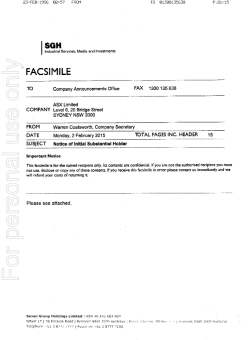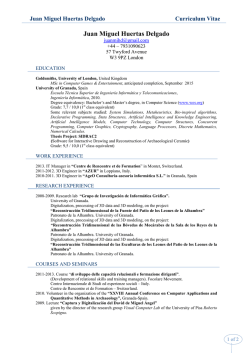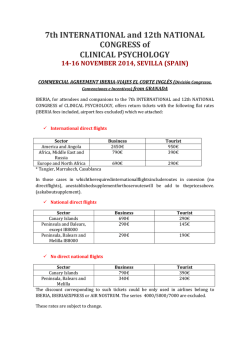
Imbalances in protein metabolism in critical care
Nutr Hosp. 2015;32(6):2848-2854 ISSN 0212-1611 • CODEN NUHOEQ S.V.R. 318 Original / Intensivos Imbalances in protein metabolism in critical care patient with systemic inflammatory response syndrome at admission in intensive care unit Hicham Bouharras El Idrissi1, Jorge Molina López1, Irene Pérez Moreno1, Daniela Ioana Florea2, Gabriela Lobo Támer3, Lourdes Herrera-Quintana1,4, Antonio Pérez De La Cruz3,5, Manuel Rodríguez Elvira5 and Elena María Planells Del Pozo1 Department of Physiology, Institute of Nutrition and Food Technology “José Mataix”, University of Granada, Granada, Spain. Moorfields Hospital. University College Hospital, London, UK. 3Nutrition & Dietetic Unit. Virgen de las Nieves Hospital, Granada, Spain. 4Department of Physical Chemistry, Faculty of Pharmacy, University of Granada, Granada, Spain. 5Intensive Care Unit. Virgen de las Nieves Hospital, Granada, Spain. 1 2 Abstract Background: trauma and severe infections cause remarkable metabolic changes in patient with SIRS from an adaptive response aimed to control the underlying disease, repairing damaged tissue, and to synthesize substrates. If the attack is intense and sustained and the patient has a compromised nutritional status, can evolve into multiple organ failure and death. Objective: assessment of nutritional proteic status and the involvement of proteins and inflammatory factors in critically ill patients. Method: multicenter observational analytical study in critical ill patients at the admission in ICU. Results and discussion: patients showed disturbances in clinical nutritional parameters which confirm their hypercatabolic situation, showing malnutrition state at admission, where 42.9% had plasma levels below the reference prealbumin. Amino acid profile was situated below the reference values and 99% of patients had low plasma transferrin. Significant differences were observed in total protein, ferritin and transferrin parameters adjusted by CRP levels, being higher when patients presented high inflammation in the case of ferritin and the opposite for the rest of parameters. Adjusting APACHE and SOFA scores according to low, medium and high severity, results showed significant differences in creatinine, urea, and transferrin, being lower at high severity grade for the last one. Correspondence: Elena María Planells del Pozo. Department of Physiology, University of Granada, Faculty of Pharmacy, Institute of Nutrition and Food Technology “José Mataix”, Avda. del Conocimiento S/N, 18071 Granada, Spain, European Union. E-mail: [email protected] ALTERACIÓN DEL METABOLISMO PROTEICO EN PACIENTE CRÍTICO CON SÍNDROME DE RESPUESTA INFLAMATORIA SISTÉMICA AL INGRESO EN LA UNIDAD DE CUIDADOS INTENSIVOS Resumen Antecedentes: el trauma y las infecciones severas causan cambios metabólicos notables en los pacientes con SRIS como una respuesta adaptativa dirigida a controlar la enfermedad subyacente, la reparación del tejido dañado y para sintetizar sustratos. Si el ataque es intenso y sostenido y el paciente tiene un estado nutricional comprometido puede evolucionar a insuficiencia orgánica múltiple y muerte. Objetivo: evaluación del estado nutricional proteico y la participación de las proteínas y los factores inflamatorios en pacientes críticamente enfermos. Método: estudio analítico observacional multicéntrico en pacientes enfermos críticos en la admisión en la UCI. Resultados y discusión: los pacientes mostraron alteraciones en los parámetros nutricionales clínicos que confirman su situación hipercatabólica, mostrando malnutrición a la admisión en UCI, donde el 42,9% tenían niveles plasmáticos de prealbúmina por debajo de la referencia. Los aminoácidos se encuentran por debajo de los valores de referencia y el 99% de los pacientes presentaron bajos niveles plasmáticos de transferrina. Se observaron diferencias significativas en los niveles de proteína total, ferritina y transferrina ajustados por los niveles de PCR, siendo mayor cuando los pacientes presentaron altos valores de inflamación, en el caso de la ferritina, y lo opuesto para el resto de parámetros. Al estratificar por las puntuaciones APACHE y SOFA de acuerdo a la gravedad baja, media y alta, los resultados mostraron diferencias significativas en creatinina, urea y transferrina, siendo menor cuanto mayor era el grado de severidad para la transferrina. Recibido: 28-VIII-2015. Aceptado: 9-X-2015. 2848 065_9827 - alteracion del metabolismo proteico.indd 2848 9/12/15 4:18 Conclusion: critical illness is characterized by a high degree of stress and accelerated degradation of proteins that cause malnutrition, systemic inflammation and organ dysfunction, with a significant association between albumin, ferritin and transferrin. Conclusión: la enfermedad crítica se caracteriza por un alto grado de estrés y la degradación acelerada de proteínas que causan malnutrición, inflamación sistémica y la disfunción de órganos, con una asociación significativa entre albúmina, ferritina y transferrina. (Nutr Hosp. 2015;32:2848-2854) (Nutr Hosp. 2015;32:2848-2854) DOI:10.3305/nh.2015.32.6.9827 DOI:10.3305/nh.2015.32.6.9827 Key words: Critical patient. Hypercatabolism. Protein status. Amino acids. SIRS. Palabras clave: Paciente crítico. Hipercatabolismo. Estatus proteico. Aminoácidos. SRIS. Abbreviations determining dysfunction and multiple organ failure (MODS)7 which would be the result of high mortality. Early detection mechanisms to detect patients with an unfavourable initial state or risk of death are essential to prevent MODS progression8. The study of biochemical parameters is a very interesting target, both for assessing the state of the disease and the analysis of intake that can provide useful information about the presence of nutritional deficiencies or excesses9. Parameters such as C-reactive protein (CRP) which is involved in different immune functions10, is a marker of inflammatory response, and high plasma concentration was related to the presence and evolution of some infections11. Its values, higher in SIRS, remain elevated in patients with multisystem dysfunction and could be normalized in patients with a good therapeutic response12. Guidelines recommended the use of this biomarker for an early bacterial detection and sepsis in patients during the first day of admission to intensive care unit (ICU)13. Albumin, prealbumin, ferritin and transferrin, among others, provide information to evaluate the overall nutritional status and protein status of critically ill patients. One of the most interesting amino acid is glutamine. This parameter is decreased in critically ill patients, increasing the risk of infections, insulin resistance and MODS14. The diminished protein parameters in critically ill patients caused by intense protein destruction and hypercatabolism become necessary the control of protein support, being absolutely necessary to be increased even in situations of increased protein loss, as in critical situation. As a result, the application of a treatment is required by nutritional support to cover the energy and essential nutrients due to their adjusted needs with the aim of preserving life and morbid-mortality15. The aim of the study was to assess the disturbances in protein metabolism of critically ill patients admitted to intensive care unit (ICU) from Granada, evaluating the nutritional state at the admission. SIRS: Systemic Inflammatory Response Syndrome. ICU: Intensive Care Unit. APACHE: Acute Physiology and Chronic Health Evaluation. SOFA: Sequential Organ Failure Assessment. MODS: Multiple Organ Dysfunction Syndrome. CRP: C Reactive Protein. ROS: Reactive Oxygen Species. AGA: American Gastroenterology Association. GLY: Glycine. SER: Serine. ARG: Arginine. GLN: Glutamine. HIS: Histidine. Introduction Malnutrition and underfeeding are major challenges in caring for critically ill patients. In critical illness, has been shown to be significantly associated with increased complications, costs, and mortality1. Therefore, nutritional adequacy as regular and systematic provision of a set of chemicals known by the generic name nutriments2 is needed to supply and maintain metabolism in critical situation. The critical ill patient is characterised by a hypercatabolic situation, high surgical stress, traumatic and shock septic, resulting in malnutrition that could be complicated by other diseases or dysfunctions. This situation may lead to a generalized inflammatory response known as systemic inflammatory response syndrome (SIRS). An exaggerated inflammatory response occurs following the release of endogenous as stress hormones and cytokines that result in significant metabolic changes3. Pro-inflammatory cytokines induces the hepatic synthesis of acute phase reactant proteins. The increase in these proteins is accompanied by a rapid decrease in lean body mass and increased urine urea nitrogen, resulting to a negative nitrogen balance4. Moreover, increased oxidative stress5 and intense generation of oxygen free radicals could promote damage on amino acids and alterations in protein conformation and its functions6. The maintained metabolic reaction in critically ill patients, could lead to consume organic protein reserve Imbalances in protein metabolism in critical care patient with systemic inflammatory response syndrome at admission... 065_9827 - alteracion del metabolismo proteico.indd 2849 Subjects and methodology Study design The study design is based on an observational and analytical study, monitoring the critically ill patient at Nutr Hosp. 2015;32(6):2848-2854 2849 9/12/15 4:18 the admission of ICU stay, from different hospitals of Southern Spain (Virgen de las Nieves, San Cecilio, General of Baza and Santa Ana of Motril, Granada). This study was approved by the Ethics Committee of the University of Granada. Written informed consent was obtained from legal relatives taking into account the approval of the Ethics Committee and the Research Committee of the Centre. The present study was conducted according to the principles of the Declaration of Helsinki and in accordance with the International Conference on Harmonization/Good Clinical Practice Standards and all procedures involving human subjects was approved by the University of Granada. Inclusion criteria were to be critically ill patients older than 18 years, admitted in the ICU; with SIRS and Acute Physiology and Chronic Health Evaluation (APACHE) II score ≥ 15; to have artificial nutritional support (enteral and mixed enteral and parenteral nutrition); to present non neurological, muscular, skeletal, or situations that affected the mouth or upper digestive tract or contraindicate the passage of nutrients to the other portions of the digestive system. Finally, a total of 115 subjects were included in the study. Nutritional assessment During ICU stay in hospitals included in our study, all patients usually receive nutritional standard supply via enteral, parenteral or combined administration based on standard formulas by the Dietary Recommended Allowances (DRAs) of Food and Nutrition Board of National Research Council (FNB-NRC)16 and the specific requirements for critically ill patients with or without sepsis by ASPEN17. Non adjusted proteic administration is performed to balance proteic metabolism. Table I shows the recommendations for protein intake according to some clinical situations (AGA, American Gastroenterology Association)18. Biochemical parameters Fasting blood samples were drawn from ICU patients by venepuncture after the hemodynamic stabiTable I Recommendations for protein intake in parenteral nutrition according to the clinical state (AGA) Daily protein requirement* Clinical state Normal 0.8 Metabolic stress 1.0-1.5 Acute renal failure without dialysis 0,8-1.0 Haemodialysis 1.2-1.4 * = g/kg/day 2850 065_9827 - alteracion del metabolismo proteico.indd 2850 Nutr Hosp. 2015;32(6):2848-2854 lization phase of admission. Total protein, albumin, creatinine, uric acid, urea and CRP will be performed by the hospital laboratory using different standard techniques. Albumin, prealbumin, ferritin, transferrin profile were determined by colorimetric immunoassay techniques using a Hitachi® (Roche Diagnostics, Germany). Amino acid profile was determined by high performance liquid chromatography (HPLC) in the central services of the University of Granada (Waters Alliance 269020®, Germany). Quality control and established procedures were performed. Data analysis Data was analysed using the SPSS statistical software (version 20.0, SPSS Inc., Chicago, USA). For continuous variables, the assumption of normality was tested using the Shapiro-Wilk curve-fitting test. Biochemical parameters were stratified according reference levels and showed as percentage of subjects. Comparative one way ANOVA test was performed to evaluate significant differences between according the grade of severity in critical ill patients which were classified in low = APACHE < 19 and SOFA < 8; Moderate = APACHE < 19 and SOFA > 8; High: APACHE > 19 and SOFA > 8. Comparative t-student test was analysed to evaluate the influence of high and low status of clinical nutritional and inflammation parameters according reference levels. Bivariate Pearson correlation test (r) was performed to evaluate the associations between biochemical parameters and critically ill severity scores. Results and discussion In critically ill patients, the demand for nutrients differs radically compared to healthy individuals as a result of profound changes in metabolism. In the United States, recent research focuses on the so-called “nutraceuticals” specific nutrients that alter the metabolic behaviour in pathological states or become “conditionally” essential in particular situations, such as liver or kidney failure19. Some amino acids have important effects as immune stimulators or specific from tissues, which may alter the course of disease with positive results. Nutritional therapy in critically ill patients could preserve lean body mass and enhance metabolic functions, although the loss of lean body mass is inevitable for the increased rate of proteolysis, amino acid mobilization from peripheral tissues to the liver to enter the gluconeogenesis pathway and produce proteins of acute phase. The physiological mission of the latter is to stimulate the immune defence, promoting wound healing and helping to recover renal function in the acid-base balance. Prolonged immobilization and, in some cases the critical condition associated starvation, also contribute to the decrease in lean mass19. Hicham Bouharras El Idrissi et al. 9/12/15 4:18 Turnover, synthesis and oxidation protein rates increase when sepsis, large wounds and the critical condition occur. The grade of this response depends on the severity of disease and the intensity of metabolic response. A protein intake of 1.1 g/kg/day in septic patients decreased protein catabolic rate, and if the contribution increases to 1.6 g/kg/day catabolism decreases further, however, above this supply protein catabolism increases again20. The balance is not positive in patients with critical contributions above 1.5 g/kg/ day21. Tables II and III show general characteristics and biochemical profile in critical ill patients at admission in ICU stay. Taking into account biochemical parameters, critical care patients showed in general disturbances in clinical nutritional parameters that confirm their hypercatabolic situation. Regarding these nutritional variables like albumin, prealbumin and transferrin, a high percentage of patients presented levels below references from the beginning of the ICU stay. Bivariate analysis showed logical significant association between clinical parameters including total protein with albumin (r = 0.42; p < 0.001), prealbumin (r = 0.26; p < 0.001) and with transferrin (r = 0.52; p < 0.001). On the other hand, transferrin was associated with albumin (r = 0.27, p < 0.001) and prealbumin (r = 0.40, p < 0.001). Herrero et al.22 attributed these changes to their property as acute phase reactant under stress, in addition to the long half-life (around 20 days). Together with albumin, prealbumin and transferrin play an important role in the assessment of nutritional status in critically ill patients, so they are widely used. In this study, the results show a malnutrition state in admission to the ICU, where almost half of the subjects (42.9%) had plasma levels below the prealbumin reference value. Sandoval et al.23 obtained similar results being directly linked to low levels of prealbumin with the highest risk of severe malnutrition in the patient. In order to focus nutritional influence, table IV shows comparative analysis of clinical nutritional and in- Table II General characteristics of patients N Critical ill Patient 111 63.5 (12.1) Men 115 68.0 Women 115 32.0 Age Mean (y) Gender Diagnostic (%) Respiratory 27 23.5 Cardiovascular 40 35.0 Abdominal 40 35.0 Other 08 6.50 APACHE II 97 19.5 (6.00) SOFA 110 8.58 (3.03) N = Sample; Mean (Sd) = Mean (standard deviation). flammation parameters according to reference levels. Taking into account nutritional parameters, patients with low status of albumin and prealbumin presented higher significant mean values for CRP, lower significant mean values for total protein and transferrin. Regarding inflammation, measured by CRP, significant differences were observed in total protein, ferritin and transferrin parameters being higher when patients presented high CRP levels in the case of ferritin and the opposite for the rest of parameters. Protein parameters by severity in critically ill patients are shown in table V. In spite of no significant association between APACHE and SOFA scores with different biochemical protein parameters, when comparing these variables according to low, medium and high severity, results showed significant differences in creatinine, urea, and transferrin, being lower at high severity grade for the last one. During SIRS, increa- Table III Biochemical parameters in critical ill patients at admission in ICU stay N Mean (Sd) Reference < Reference value (%) > Reference value (%) Urea (mg/dL) 111 87.5 (53.3) 70-110 45.9 27.8 Creatinine (mg/dL) 114 2.07 (1.69) 0.8-1.2 23.7 64.0 Uric Acid (mg/dL) 107 5.35 (2.73) 3-7 22.4 26.2 PCR (mg/dL) 92 18.7 (13.7) 0.1-1 0 95.7 Total proteins (g/100 mL) 112 5.15 (0.96) 6-8 83.0 0 Albumin (g/dL) 110 2.70 (0.61) 3-5 73.6 0 Prealbumin (mg/dL) 105 13.7 (8.69) 10-40 42.9 1.00 Ferritin (ng/mL) 115 534.0 (712.0) 12-119 0 90.4 Transferrin (mg/dL) 103 142.4 (57.7) 245-370 99.0 0 N = Sample; Mean (Sd) = Mean (standard deviation). Imbalances in protein metabolism in critical care patient with systemic inflammatory response syndrome at admission... 065_9827 - alteracion del metabolismo proteico.indd 2851 Nutr Hosp. 2015;32(6):2848-2854 2851 9/12/15 4:18 Table IV Comparative analysis of clinical nutritional and inflammation parameters according to reference levels Albumin Prealbumin CRP Low High Low High Low High Mean (Sd) Mean (Sd) Mean (Sd) Mean (Sd) Mean (Sd) Mean (Sd) APACHE 19.5 (5.5) 18.6 (6.87) 19.8 (5.26) 18.8 (6.44) 21.3 (4.04) 19.0 (5.83) SOFA 8.61 (2.91) 8.17 (3.20) 8.40 (3.20) 8.70 (2.91) 10.0 (2.16) 8.46 (2.94) Urea (mg/dL) 90.6 (55.3) 77.8 (48.2) 85.4 (55.5) 86.9 (53.8) 75.2 (33.8) 82.8 (47.0) Creatinine (mg/dL) 2.17 (1.72) 1.61 (1.17) 1.79 (1.54) 2.18 (1.68) 1.57 (1.22) 2.02 (1.66) Uric acid (mg/dL) 5.19 (2.81) 5.72 (2.60) 4.92 (5.42) 5.42 (2.67) 4.56 (2.49) 5.13 (2.50) CRP (mg/dL) 21.0 (13.3) 13.7 (13.2)* 24.5 (15.7) 15.8 (11.1)** Total protein (g/dL) 4.90 (0.81) 5.89 (0.87) 5.04 (0.93) 5.22 (0.93) 6.07 (0.49) 5.11 (0.92)* 0.20 (0.40) 0.28 (0.45) 4.13 (0.15) 2.67 (0.58) 18.1 (15.2) 13.4 (7.44) Albumin (g/dL) Prealbumin (mg/dL) - ** - - - - - 13.0 (7.72) 15.4 (11.1) Ferritin (ng/mL) 570.8 (768.1) 363.9 (463.5) 519.9 (675.6) 537.1 (754.0) 195.5 (162.5) 482.8 (640.8)* Transferrin (mg/dL) 132.5 (51.2) 171.4 (66.6)** 121.5 (48.2) 157.9 (59.6)** 212.6 (25.4) 138.7 (58.7)* N = Sample; Mean (Sd) = Mean (standard deviation); Statistically significant differences t-student test * p < 0.05; **p < 0.01. High = Value above references; Low = Value under references. sed protein catabolism promotes a significant decrease in the rate of protein synthesis called acute phase protein. Among these proteins, CRP increased during critical illness24 and could explain the high levels of this protein obtained in our study. It is well known that many critically ill patients are severely catabolic and lose mainly muscle protein. The most obvious way to prevent or counteract this loss is by protein feeding. In our study, regarding amino acid profile, Gly (Glycine), Ser (Serine), Arg (Arginine), Glu (Glutamine) e His (Histidine) were situated below the reference values, and 84.5 percent of patients had plasma transferrin (99.0 percent). The amino acids that come from proteolysis following the breakdown of muscle proteins are transported to the liver for use in the synthesis of acute phase proteins and other intended tissue repair. This increases the demand for amino acids in the acute pathophysiological situation25 and confirms the low levels found in our results. Certain amino acids exert a pharmacological action in the critical state if given in higher than normal oral intake or nutritional support standard, or what is more important doses viewing requirements of certain amino acids, such as essentials, that change in the critically ill as a result of alterations in metabolic demand. It is hypothesized that if conditionally essential amino acids are proportionately in critical condition, it is easier to meet the metabolic demands and improves clinical evolu- Table V Protein parameters by severity in critically ill patients Low Moderate High Creatinine (mg/dL) 1.47 (0.94) c 2.27 (1.48) 3.25 (2.43)c Transferrin (mg/dL) 155.0 (57.1)c 135.0 (62.0) 117.0 (50.8)c 102.8 (47.9)a 117.9 (70.0)c Urea (mg/dL) 66.7 (39.3)a,c Albumin (g/dL) 2.73 (0.47) 2.77 (0.68) 2.54 (0.67) Ferritin (ng/mL) 473.3 (645.1) 620.6 (937.3) 543.8 (618.6) 20.1 (12.8) 17.3 (14.7) 20.0 (16.3) Prealbumin (mg/dL) 13.91 (9.24) 13.97 (8.93) 13.66 (9.28) Total protein (g/dL) 5.10 (0.97) 5.19 (0.94) 4.90 (0.95) CRP (mg/dL) Severity: Low = APACHE < 19 and SOFA < 8; Moderate = APACHE < 19 and SOFA > 8; High: APACHE > 19 and SOFA > 8; Significant values by severity: a = Low vs Moderate; b = Moderate vs High; c = Low vs High 2852 065_9827 - alteracion del metabolismo proteico.indd 2852 Nutr Hosp. 2015;32(6):2848-2854 Hicham Bouharras El Idrissi et al. 9/12/15 4:18 tion19. Therefore, in this situation it is obvious the need for intervention through proper nutrition that includes a balanced intake of protein, although recommendations for critical patients are still unclear26, varying from 1.2 to 2.5 g/kg/day17,27. In these conditions of hypercatabolism, plasma glutamine levels are reduced, which is associated with a poor prognosis. Supplementation with amino acids in general and glutamine in particular, will be crucial. Abilés et al.28 observed that the supply of glutamine in critically ill patients improves the antioxidant defenses and thereby lower morbidity during the ICU stay. In 2015, Liebau et al.29 concluded that an amino acid infusion improves short-term body balance of proteins in patients with critical condition. Conclusion Critical illness is characterized by a high degree of stress and accelerated degradation of proteins that cause malnutrition, systemic inflammation and organ dysfunction, with a significant association between plasma proteins such as albumin, transferrin and ferritin as we found in our study. The present study confirms that it is essential to carry out a monitoring protein profile early in the stay, applying personalized nutritional support to reduce morbidity and mortality, and complications with shorten ICU stay, optimizing the response to treatment. Conflict of interest For each author listed on this manuscript, there is no personal or financial support or author involvement with an organization with financial interest in the subject matter and no conflict of interest exists. The authors declare that they have no competing interests. Acknowledgments We thank all hospital professionals (Virgen de las Nieves, San Cecilio, General of Baza and Santa Ana of Motril, Granada, Spain), especially ICU and the Service of Clinical Analysis personnel. We also thank the Supported Unit for Investigation FIBAO (Foundation for the Health Investigation). Financial support for the study was provided by Project FIS PI10/1993 from the Spanish Carlos III Health Institute and FEDER European Funds. References 1. Allingstrup MJ, Esmailzadeh N, Wilkens Knudsen A, et al. (2012) Provision of protein and energy in relation to measured requirements in intensive care patients. Clin Nutr Edinb Scotl 31: 462–468. Imbalances in protein metabolism in critical care patient with systemic inflammatory response syndrome at admission... 065_9827 - alteracion del metabolismo proteico.indd 2853 2. Brooks S & Kearns P (1997) Nutrición enteral y parenteral. In: Ekhard E, Ziegler EE, Filer LJ Conocimientos actuales sobre nutrición. 7ma Ed. Washington. DC: OPS/OMS ILSI Press 567-76. 3. Barton RG (1994) Nutrition support in critical illness. Nutr Clin Pract Off Publ Am Soc Parenter Enter Nutr 9: 127–139. 4. Landucci F, Mancinelli P, De Gaudio A at al (2014) Selenium supplementation in critically ill patients: a systematic review and meta-analysis J Crit Care 29: 150-156. 5. Andresen HM, Regueira HT & Leighton F (2006) Oxidative stress in critically ill patients Rev Médica Chile 134: 649-656. 6. Victor VM, Rocha M, Esplugues JV et al. (2005) Role of free radicals in sepsis: antioxidant therapy Curr Pharm Des 11: 3141-3158. 7. Stephenson JA, Gravante G, Butler NA, et al. (2010) The Systemic Inflammatory Response Syndrome (SIRS)--number and type of positive criteria predict interventions and outcomes in acute surgical admissions World J Surg 34, 2757-2764. 8. Suberviola B, Castellanos-Ortega A, González-Castro A, et al. (2012) Prognostic value of procalcitonin, C-reactive protein and leukocytes in septic shock Med Intensiva Soc Esp Med Intensiva Unidades Coronarias 36: 177-184. 9. Mataix J (2009) Alimentación y Nutrición Humana. Situaciones Fisiológicas y Patológicas Ed Ergon. 10. Pierrakos C & Vincent JL (2010) Sepsis biomarkers: a review. Crit Care Lond Engl 14: R15. 11. Barati M, Alinejad F, Bahar MA, et al. (2008) Comparison of WBC, ESR, CRP and PCT serum levels in septic and non-septic burn cases. Burns J Int Soc Burn Inj 34: 770-774. 12. Yentis SM, Soni N & Sheldon J (1995) C-reactive protein as an indicator of resolution of sepsis in the intensive care unit. Intensive Care Med 21, 602-605. 13. Tschaikowsky K, Hedwig-Geissing M, Braun GG. et al. (2011) Predictive value of procalcitonin, interleukin-6, and C-reactive protein for survival in postoperative patients with severe sepsis. J Crit Care 26: 54-64. 14. Wischmeyer PE, Dhaliwal R, McCall M., et al. (2014) Parenteral glutamine supplementation in critical illness: a systematic review Crit Care Lond Engl 18: R76. 15. Heyland DK, Dhaliwal R & Drover JW (2004) Nutrition support in mechanically ventilated, critically ill adult patients: are we ready for evidence-based clinical practice guidelines? Nutr Clin Pract Off Publ Am Soc Parenter Enter Nutr 19: 193200. 16. Recommended Dietary Allowances: 10th Edition (1989) Subcommittee on the Tenth Edition of the RDAs Food and Nutrition Board Commission on Life Sciences National Research Council National Academy Press Washington, D.C. at http:// www.nap.edu/openbook.php?record_id = 1349. 17. McClave SA, Martindale RG, Vanek VW, et al. (2009) Guidelines for the Provision and Assessment of Nutrition Support Therapy in the Adult Critically Ill Patient: Society of Critical Care Medicine (SCCM) and American Society for Parenteral and Enteral Nutrition (A.S.P.E.N.) JPEN J Parenter Enteral Nutr 33: 277-316. 18. Koretz RL, Lipman TO, Klein S et al. (2001) AGA technical review on parenteral nutrition. Gastroenterology 121: 9701001. 19. De Legge MH, Mattox T, Mueller C et al. (2007) The A.S.P.E.N Nutrition Support Core-Curriculum: A Case-Based Approach-The Adult Patient. The American Society for Parenteral and Enteral Nutrition. 107-208. 20. Shaw JH, Wildbore M & Wolfe RR (1987) Whole body protein kinetics in severely septic patients. The response to glucose infusion and total parenteral nutrition. Ann Surg 205: 288-294. 21. Jacobs DG, Jacobs DO, Kudsk KA, et al. Practice management guidelines for nutritional support of the trauma patient. J Trauma 57: 660-678. 22. Herrero Domínguez-Berrueta, MC, Martín de Rosales Cabrera, AM & Pérez Encinas M (2014) Analysis of the nutritional parameters and adjustment of the requirements of the initial parenteral nutrition in post surgical critically ill patients Nutr Hosp 29: 402-410. Nutr Hosp. 2015;32(6):2848-2854 2853 9/12/15 4:18 23. Almengor JS, Granillo JF, Sánchez JA, et al. (2010) Pronóstico de la delta de prealbúmina en el paciente grave con alto riesgo de desnutrición Rev Asoc Mex Med Crítica Ter Intensiva 84-89. 24. Kecskes C (2007) Soporte nutricional en el paciente traumatizado. In Ceraso D editor. Terapia Intensiva. Buenos Aires: Ed Panamericana 1039-44. 25. Berger MM, Binnert C, Chiolero RL, et al. Trace element supplementation after major burns increases burned skin trace element concentrations and modulates local protein metabolism but not whole-body substrate metabolism. Am J Clin Nutr 85: 1301-1306. 2854 065_9827 - alteracion del metabolismo proteico.indd 2854 Nutr Hosp. 2015;32(6):2848-2854 26. Hoffer LJ & Bistrian BR (2012) Appropriate protein provision in critical illness: a systematic and narrative review Am J Clin Nutr 96: 591-600. 27. Singer P, Berger MM, Van den Berghe G, et al. (2009) ESPEN Guidelines on Parenteral Nutrition: Intensive care Clin Nutr 28: 387-400. 28. Abilés J, Moreno-Torres R, Moratalla G, et al. (2008) Effects of supply with glutamine on antioxidant system and lipid peroxidation in patients with parenteral nutrition Nutr Hosp 23: 332-339. 29. Liebau F, Sundström M, van Loon LJC, et al. (2015) Short-term amino acid infusion improves protein balance in critically ill patients Crit Care Lond Engl 19: 106. Hicham Bouharras El Idrissi et al. 9/12/15 4:18
© Copyright 2026





